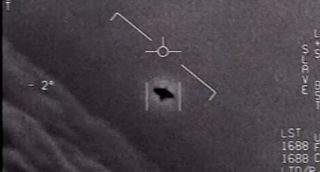
NASA hopes it can help move the study of unidentified aerial phenomena (UAP) off the scientific fringes and into the mainstream.
The agency announced today (June 9) that it has commissioned a panel to investigate UAP, a recent rebranding that is pushing out the more familiar term "unidentified flying object" (UFO).
The NASA study will begin this fall, take about nine months to complete and cost no more than $100,000, agency officials said during a call with reporters today. The main goal is to assess the state of the UAP data landscape and how it can be improved going forward.
Related: US military taking 'all hands on deck' approach to understanding UFOs
"The study will focus on identifying available data, how to best collect future data and how NASA can use these data to move the scientific understanding of UAPs forward," Thomas Zurbuchen, the associate administrator for science at NASA headquarters in Washington, said during today's call.
Or, in other words, "take a field that is relatively data poor and make it into a field that is much more data rich and therefore worthy of scientific investigation and analysis," he added.
Such work is very much in NASA's bailiwick, Zurbuchen said, noting that the agency's many research priorities cover, among other things, the hunt for alien life, investigating mysterious cosmic objects and phenomena and helping to keep American aircraft safe and secure. (The first "A" in NASA stands for "aeronautics," and UAP could represent a threat to planes and other aerial vehicles.)
Get the Space.com Newsletter
Breaking space news, the latest updates on rocket launches, skywatching events and more!
And, like the U.S. Department of Defense, NASA is not afraid to put its name behind the push to demystify UAP. (The DoD has set up multiple UAP-studying task forces in the past few years, stressing that understanding the phenomena is important for national security purposes.)
"In a traditional type of science environment, talking about some of these issues may be considered kind of selling out or talking about things that are not actual science," Zurbuchen said. "I just really vehemently oppose that. I really believe that the quality of science is not only measured by the outputs that come behind it but also the questions we're willing to tackle with science."
Indeed, NASA hopes that the newly announced panel, and the work that it does, will help normalize UAP sightings and research, bringing more and better information into scientists' databases.
"One of the things you might have heard in the congressional hearings a few weeks ago was, there is a great deal of stigma associated with UAP among our naval aviators and in the aviation community," Daniel Evans, assistant deputy associate administrator for research at NASA's Science Mission Directorate, said during today's call. Evans is the NASA official responsible for orchestrating the study, which will be led by astrophysicist David Spergel, president of the Simons Foundation in New York City.
"One of the things that we tangentially hope to be part of this study, simply by talking about it in the open, is to help to remove some of the stigma associated with it," Evans added. "That will yield, obviously, increased access to data, more reports, more sightings, et cetera. So that's another thing that we're trying to accomplish with it."
Mike Wall is the author of "Out There" (Grand Central Publishing, 2018; illustrated by Karl Tate), a book about the search for alien life. Follow him on Twitter @michaeldwall. Follow us on Twitter @Spacedotcom or on Facebook.
Join our Space Forums to keep talking space on the latest missions, night sky and more! And if you have a news tip, correction or comment, let us know at: community@space.com.

Michael Wall is a Senior Space Writer with Space.com and joined the team in 2010. He primarily covers exoplanets, spaceflight and military space, but has been known to dabble in the space art beat. His book about the search for alien life, "Out There," was published on Nov. 13, 2018. Before becoming a science writer, Michael worked as a herpetologist and wildlife biologist. He has a Ph.D. in evolutionary biology from the University of Sydney, Australia, a bachelor's degree from the University of Arizona, and a graduate certificate in science writing from the University of California, Santa Cruz. To find out what his latest project is, you can follow Michael on Twitter.